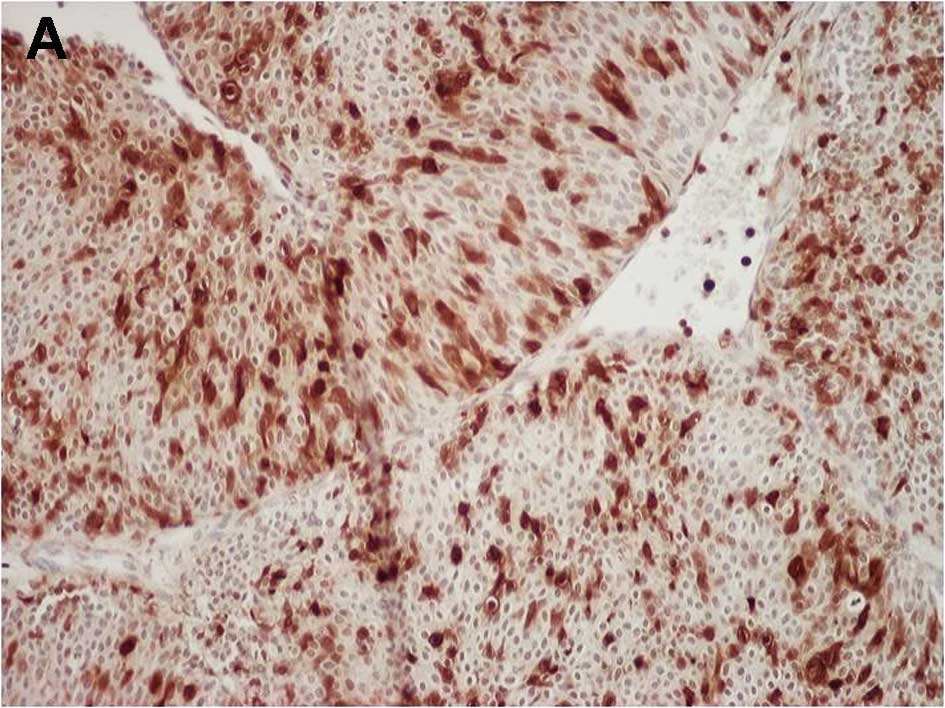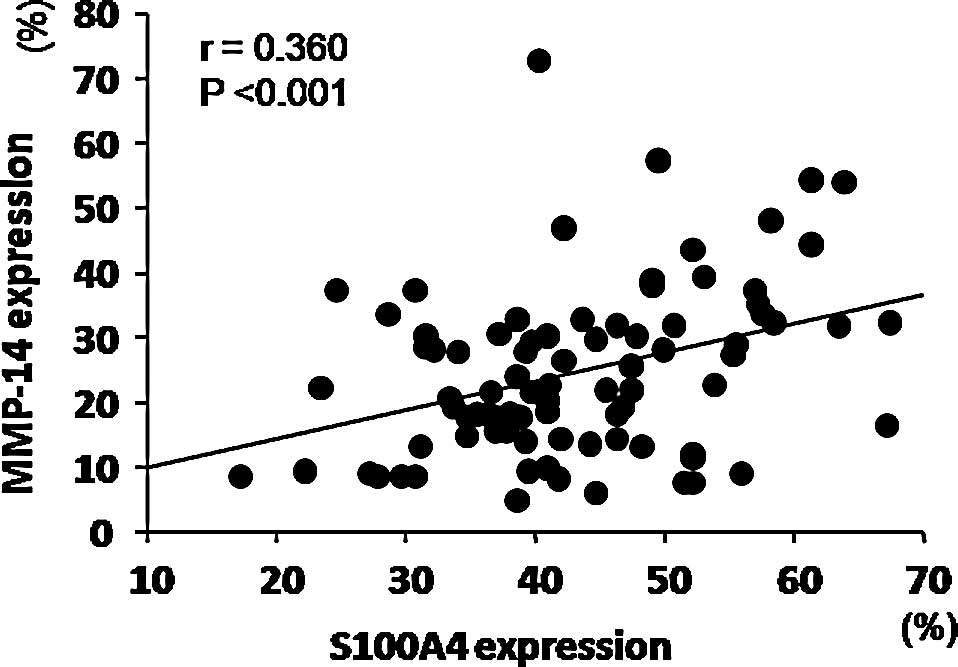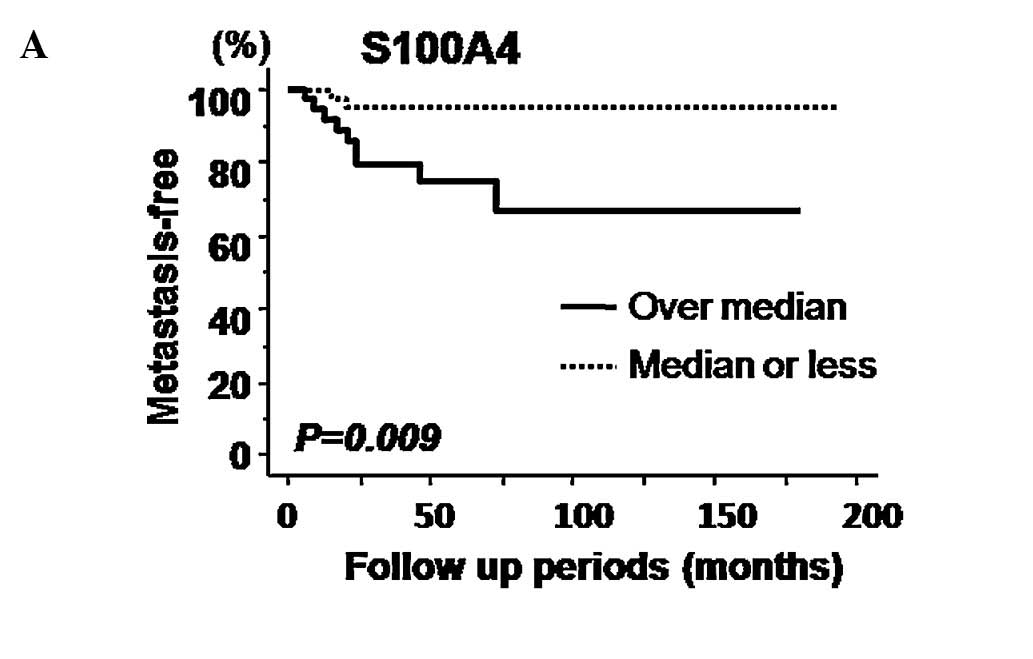Clinical significance and prognostic value of S100A4 and matrix metalloproteinase-14 in patients with organ-confined bladder cancer
- Authors:
- Published online on: January 1, 2010 https://doi.org/10.3892/etm_00000005
- Pages: 27-31
Abstract
Introduction
The S100 protein family is associated with cell differentiation, cell motility and transcriptional regulation (1). S100A4 is a member of this family and is found as a highly expressed transcript in metastatic tumor cell lines (2). S100A4 is up-regulated in several malignancies including bladder cancer, and plays a role in tumor aggressiveness (3,4). However, the exact pathological role of S100A4 in bladder cancer remains unclear; little is known about its role in tumor invasiveness and prognostic significance in patients with organ-confined tumors.
In general, few symptoms are apparent when bladder cancer cells are localized to the submucosal layer (superficial tumor). Such patients are usually treated by transurethral resection (TUR) and/or intravesical therapy without any severe negative effect on quality of life (QOL). Although threequarters of newly diagnosed patients with bladder cancer have superficial tumors, approximately 70% of these recur in the urinary tract and 4–45% of recurrent tumors develop muscle invasive disease (5,6). Patient prognosis worsens when cancer cells reach surrounding tissues and distant organs, and when TUR becomes an ineffective method of treatment. Thus, it is conceivable that prevention of muscle invasion is crucial for maintenance of QOL and improvement of prognosis in patients with superficial bladder cancer.
The mechanisms at play early in bladder cancer development are not fully understood, despite this step being the most important determinant for choice of therapeutic strategy and prognosis. In addition, treatment strategies for bladder cancer vary markedly between patients with organ-confined tumors and those with extravesical extension including metastasis. Although several effective therapies are available for tumors ≤ pT2 stage (7,8), only a few options are available with a satisfactory outcome in patients with pT3 or pT4 and/or metastasis (8). Researchers and clinicians therefore need better information regarding predictive factors for progression to an advanced stage in patients with organ-confined bladder cancer.
Various members of the matrix metalloproteinase (MMP) family are reported targets of S100A4 (9). One of the most representative functions of MMPs is proteolytic degradation of extracellular matrix (ECM). Such degradation is important for cancer cell invasion, and a variety of MMPs are associated with cancer cell progression in many malignancies (10). MMP-2, -9 and -14 are also regulated by S100A4 (11–13), while MMP-2 and -9 are of clinical significance in bladder cancer (14). Several reports also cite the clinical and pathological significance of MMP-14 in bladder cancer (15–18), although its pathological role in the early steps of invasion remains unknown. In addition, the possible direct relationship between S100A4 and MMP-14 expression in human bladder cancer is uncharted.
The aim of this retrospective study was to clarify the pathological roles of S100A4 and MMP-14 in early-stage bladder cancer cell invasion of muscle. In addition, predictive factors for metastasis and survival in patients with organ-confined tumors were also investigated. The findings identified S100A4 expression as a useful prognostic marker in patients with organ-confined disease.
Materials and methods
Patients and tumor samples
We reviewed consecutive surgical specimens of bladder cancer obtained at our hospital from 1995 to 2003. Furthermore, we also examined 15 normal tissue samples of the urinary bladder obtained from apparently normal areas of the bladder of patients with transitional cell carcinoma of the upper urinary tract. None of these patients showed recurrence within a follow-up period of 6–13 years. Patients who received neo-adjuvant therapy were excluded. Tumors were staged according to the 2004 American Joint Committee on Cancer and graded according to the World Health Organization and International Society for Urological Pathology classification system. Patients diagnosed with metastatic tumor and/or pT3 or pT4 were also excluded from the study. Fifteen patients did not receive adjuvant therapy (17.6%). There were no significant differences in S100A4 expression (p=0.783) and MMP-14 expression (p=0.165) between patients who received and did not receive adjuvant therapy. The median duration of follow-up was 53 months (range, 2–195 months). The study protocol met the ethical standards of the Human Ethics Review Committee of Nagasaki University School of Medicine.
Immunohistochemistry
Anti-S100A4 (Zymed Laboratories, San Francisco, CA, USA) and anti-MMP-14 (Lab Vision Corporation, Fremont, CA, USA) antibodies were used for immunostaining. Sections (5 μm thick) were deparaffinized and rehydrated. Antigen retrieval was performed at 95°C for 40 min in 0.01 M sodium citrate buffer (pH 6.0). All sections were then immersed in 3% hydrogen peroxide for 30 min to block endogenous peroxidase activity. Sections were incubated overnight with the primary antibody at 4°C, and then incubated with peroxidase using the labelled polymer method with Dako EnVision+™ Peroxidase (Dako Corp., Carpenteria, CA, USA) for 60 min. The peroxidase reaction was visualized with the liquid 3,3-diaminobenzidine tetrahydrochloride (DAB) substrate kit (Zymed Laboratories). Sections were counterstained in hematoxylin. Breast cancer and prostate cancer tissues were used as positive controls for S100A4 and MMP-14, respectively, according to previous reports (19,20). A consecutive section from each sample processed without the primary antibody was used as a negative control.
The expression levels of each molecule were evaluated semiquantitatively, taking into account the percentage of positively stained cancer cells per field of microscopic view [at least 300 carcinoma cells were examined in high-power fields (×200)]. Expression was considered positive when the antibody staining intensity was strong. The percentage of positively stained cancer cells was determined using a continuous scale. Slides were evaluated twice at different times by two investigators (Y.M. and Y.S.), who were blinded to the clinical and pathological features of the tumor.
Statistical analysis
All data are expressed as the median and interquartile range (IQR). The Fisher’s exact test was used to categorically compare data. Spearman’s rank correlation coefficient was calculated to confirm Pearson’s correlation. Survival was evaluated by Kaplan-Meier analysis and the log-rank test. To quantify the survival analysis, patients were divided into two groups: high S100A4 expression (>median) and low expression (≤median), and pT stage was also divided into two groups: low (pTa and 1) and high pT stage (pT2). Variables that achieved statistical significance (p<0.05) by univariate analysis were subsequently entered into a multivariate analysis [described as odds ratios (OR) with 95% confidence intervals (95% CIs), together with the p-values]. All statistical analyses were two-sided, and significance was defined as p<0.05. All statistical analyses were performed on a personal computer with the statistical package, StatView for Windows (version 5.0, Abacus Concept, Inc., Berkeley, CA, USA).
Results
Immunohistochemical expression and pathological significance
Fig. 1A and B show representative examples of S100A4 and MMP-14 immunostaining, respectively, in bladder cancer cells. The proportion of S100A4- and MMP-14-positive cancer cells relative to the total cell number was 41.6% (36.5–50.9%) and 22.3% (15.9–32.0%), respectively. In stroma tissues, some fibroblast cells and infiltrating cells showed positive staining for S100A4 and MMP-14, respectively. However, such expression was not so strong and their frequencies were very low. In normal urothelium, strong expression for both S100A4 and MMP-14 were not found in all specimens.
This study consisted of 65 men and 20 women, and the median (IQR) age was 70 (61–70) years. The gender was not associated with expression of S100A4 or MMP-14 (p=0.316 or 0.812, respectively). Likewise, age was not associated with expression of S100A4 or MMP-14 (p=0.613 or 0.712, respectively). Table I summarizes the relationships between clinicopathological features of the cancer and expression levels of S100A4 or MMP-14. The proportion of S100A4-positive cancer cells in pT2 tumors was significantly higher than in either pTa or pT1 tumors, but similar in the latter two stages of tumors (p=0.823). The findings were similar for MMP-14 expression and tumor stage (Table I). With respect to tumor grade, S100A4-positive cancer cells were significantly more abundant in high grade than in low grade cases (p=0.023). However, no such relationships were found with MMP-14 expression (p=0.338). Finally, S100A4 expression correlated positively with MMP-14 expression (r=0.360, Fig. 2).
Correlation with prognosis
Kaplan-Meier curves for metastasis-free survival relative to expression of S100A4 and MMP-14 are presented in Fig. 3A and B, respectively. Log-rank tests identified S100A4, but not MMP-14 expression, as a significant predictive factor of metastasis-free survival. However, neither S100A4 nor MMP-14 expression was significantly related to cause-specific survival (Fig. 3C and D). A potential role for S100A4 in distant metastasis was investigated in more detail using a multivariate analysis model including pT stage and grade. High pT stage was identified as a significant predictive factor (OR=6.19, 95% CI=1.41–27.27, p=0.016), however, S100A4 expression and high grade did not qualify as a significant predictor by this analysis (OR=3.40, 95% CI=0.59–19.47, p=0.170 and OR=1.16, 95% CI=0.21–6.53, p=0.869, respectively).
Discussion
In this study, S100A4 expression in pT2 bladder tumors was significantly higher than in superficial tumors (pTa and pT1). Proportions of S100A4-positive bladder cancer cells in invasive tumors (pT2-4) were previously reported to be higher than in superficial tumors (4,21). However, these studies did not discuss relative differences in S100A4 expression among pTa, pT1 and pT2 tumors. In general, invasiveness-related proteins tend to be up-regulated in proportion to cancer stage. Thus, it is possible that comparing S100A4 expression in superficial tumors with the entire pT2-4 spectrum does not always reflect the exact role of this protein in the early invasion stages. Spread of cancer cells into surrounding muscle is one of the most important determinants for successful QOL and prognosis, justifying the importance of comparing superficial tumors with pT2, but not with the whole tumor spectrum. S100A4 was found to be important in the early stages of muscle invasion in the current study, providing important new information for planning treatment strategies for patients with superficial bladder tumors.
The results presented herein also showed that proportions of MMP-14-positive cancer cells in pT2 tumors were significantly higher than in superficial tumors. Only one published study previously examined the relationship between MMP-14 expression and pT stage, showing no significant association (15). However, this analysis only measured MMP-14 expression in whole samples obtained at surgery, and not in selected ones. In another study of samples obtained by laser capture microdissection, MMP-14 expression differed between tumor epithelium and stroma (18). From this result, the use of whole sample in the former study might not reflect the invasive function of MMP-14 in bladder cancer cells, as might different sample sizes (41 vs. 85). We speculate that MMP-14 is indeed associated with muscle invasion of bladder cancer cells.
Of additional interest is the positive correlation shown between S100A4 and MMP-14 expression. Several metastasisrelated molecules are regulated by S100A4. DeLassus et al (22) recently showed that overexpression of S100A4 in human breast cancer cells correlated positively with MMP-14 expression. The present study also showed a similar relationship between pT stage and S100A4 or MMP-14. Although the expression of both proteins in invaded muscle tissue differed significantly from those in superficial tumors, there was no significant difference between pTa and pT1 with regard to gene expression of S100A4 and MMP-14. These findings implicate S100A4 in bladder cancer cell invasion into muscle layer via the regulation of MMP-14.
Univariate survival analyses identified S100A4 expression as a significant predictor of metastasis-free survival in patients with organ-confined bladder cancer, supporting previous reports of S100A4 expression and metastasis in bladder cancer (4,19,23). However, S100A4 expression was not identified as a significant predictor in multivariate analyses. In this study, S100A4 expression was associated with both pT stage and grade and these factors were also significant predictors for metastasis-free survival. So, we hypothesized that S100A4 was not a independent predictor in multivariate analysis. On the other hand, several investigators reported S100A4 expression to be a significant predictor of bladder cancer-specific survival (4,23), although the current study found no such association. None of our patients had extravesical tumor extension (pT3 or pT4) and/or metastasis unlike these earlier studies, possibly accounting for the discrepancy. On the other hand, MMP-14 expression was not associated with metastasis-free survival. S100A4 was reported to regulate MMP-2 and MMP-9, in addition to MMP-14 (11–13). We speculate that MMP-14 plays minimum roles in the steps of metastasis.
In conclusion, S100A4 is potentially important during early muscle invasion in bladder cancer via its regulation of MMP-14. The present study identified S100A4 expression as a significant prognostic factor for metastasis-free survival in patients with organ-confined tumors.
Acknowledgements
We are grateful to Mr Yoshikazu Tsuji and Mr Takumi Shimogama for the outstanding support. This study was not supported by any grants and funds.












